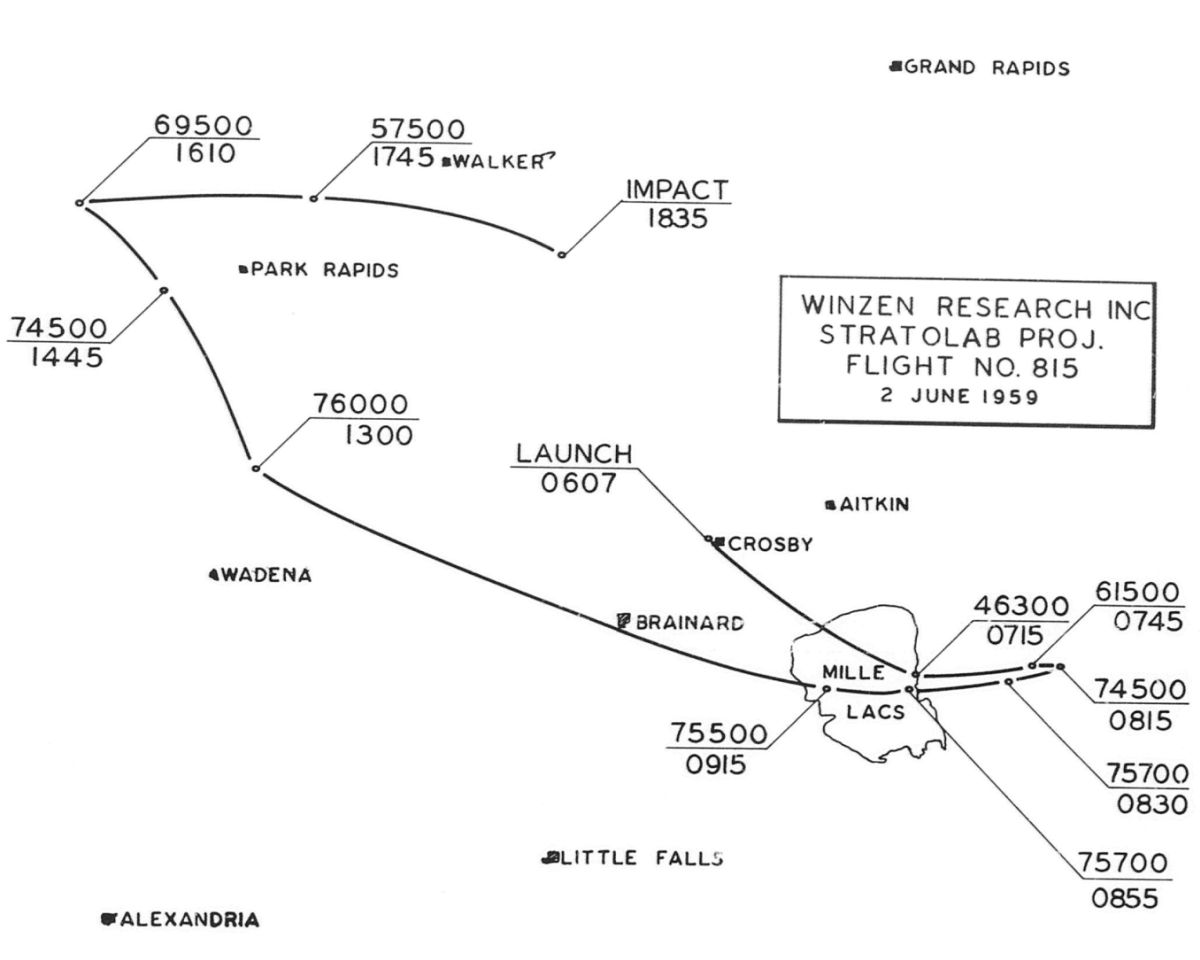Purpose of the flight and payload description
The mission aimed to test a balloon similar to the one planned for the STRATOLAB HIGH #4 mission later that year. The balloon, developed by Winzen Research Inc., had a volume of 2 million cubic feet and was made of 2-mil polyethylene with reinforced seams and 500-pound Fortisan load bands. Encouraging results from several indoor inflation tests led to the decision to proceed with a simulated load flight test of the new balloon.
The payload carried by the balloon consisted of a mock-up of the STRATOLAB gondola and telescope system to be used in the STRATOLAB HIGH #4 mission. The gondola was constructed of steel pipe in a spherical configuration covered by white polyethylene film. The telescope mock-up was fabricated from a water tank mounted similarly to the telescope on the STRATOLAB gondola. A second tank was mounted inside the framework of the gondola to carry steel shot ballast, simulating the gross load of the STRATOLAB system. To simulate the center of gravity of the actual STRATOLAB system, 800 pounds of control ballast was suspended from the anti-roll ring at the top of the gondola. This ballast was contained in plastic bags, which could be blown open by radio command.
Also onboard were photographic and movie cameras: a Kodak K-100 16 mm movie camera modified to take time-lapse photographs of the balloon periphery; a Praktina 35 mm time-lapse camera to photograph the base of the balloon; and an 8 mm movie camera modified to provide time-lapse photographs of the Earth for obtaining rotational stability data.
Additional imaging gear was also included as "piggy-back" payloads for third parties: two P220 cameras flown for NADC Johnsville, Pennsylvania, to study stratospheric cloud phenomena, and a Kodak Model B 16 mm movie camera modified to provide time-lapse photographs of cloud formations at a rate of 4 f.p.m. This camera was flown for Mr. Charles B. Moore of the Arthur D. Little Company of Cambridge, Massachusetts.
Details of the balloon flight

Balloon launched on: 6/2/1959 at 6:07 CDT
Launch site: Portsmouth Mine, Crosby, Minnesota, US
Balloon launched by: Winzen Research Inc.
Balloon manufacturer/size/composition: Zero Pressure Balloon Winzen 2.000.000 cuft
Balloon serial number: 172.6-200-V-65
Flight identification number: WRI 815
End of flight (L for landing time, W for last contact, otherwise termination time): 6/2/1959 at 18:35 CDT (L)
Balloon flight duration (F: time at float only, otherwise total flight time in d:days / h:hours or m:minutes - ): 12 h 30 m
Landing site: Near Walker, Minnesota, US
Payload weight: 1057 lbs
Overall weight: 5496 lbs
Following the completion of preliminary preparations of the gondola on the evening of 1 June, actual flight preparations commenced at 03:00 CDT on 2 June. A gross inflation of 5,496 pounds was completed at 05:40 CDT, and the flight was launched at 06:07 CDT from the open pit of the Feigh Mine of the M.A. Hanna Company at Crosby, Minnesota. The payload, weighing 4,032 pounds, was the heaviest ever flown on a plastic balloon. The balloon reached a ceiling altitude of 75,500 feet at approximately 08:20 CDT and drifted generally northeastward throughout the remainder of the flight.
Inability to exercise command and control of the ballast drops precluded maintaining flight altitude as the balloon lost its superheat. The flight was terminated by a mechanical timer during the afternoon of the same day, and the load landed near Walker, Minnesota. The flight was considered successful in accomplishing its primary objective-determining the balloon's capability to support such a load during its ascent and at its ceiling altitude. Good photographic data was obtained from the cameras flown and utilized for evaluating the balloon's performance characteristics.
External references
- Flight Summary Log Winzen Research Inc. report (1963)
- Strato Lab High #4 Post Flight Report Winzen Research Inc Technical Report, 1961
29If you consider this website interesting or useful, you can help me to keep it up and running with a small donation to cover the operational costs. Just the equivalent of the price of a cup of coffee helps a lot.

